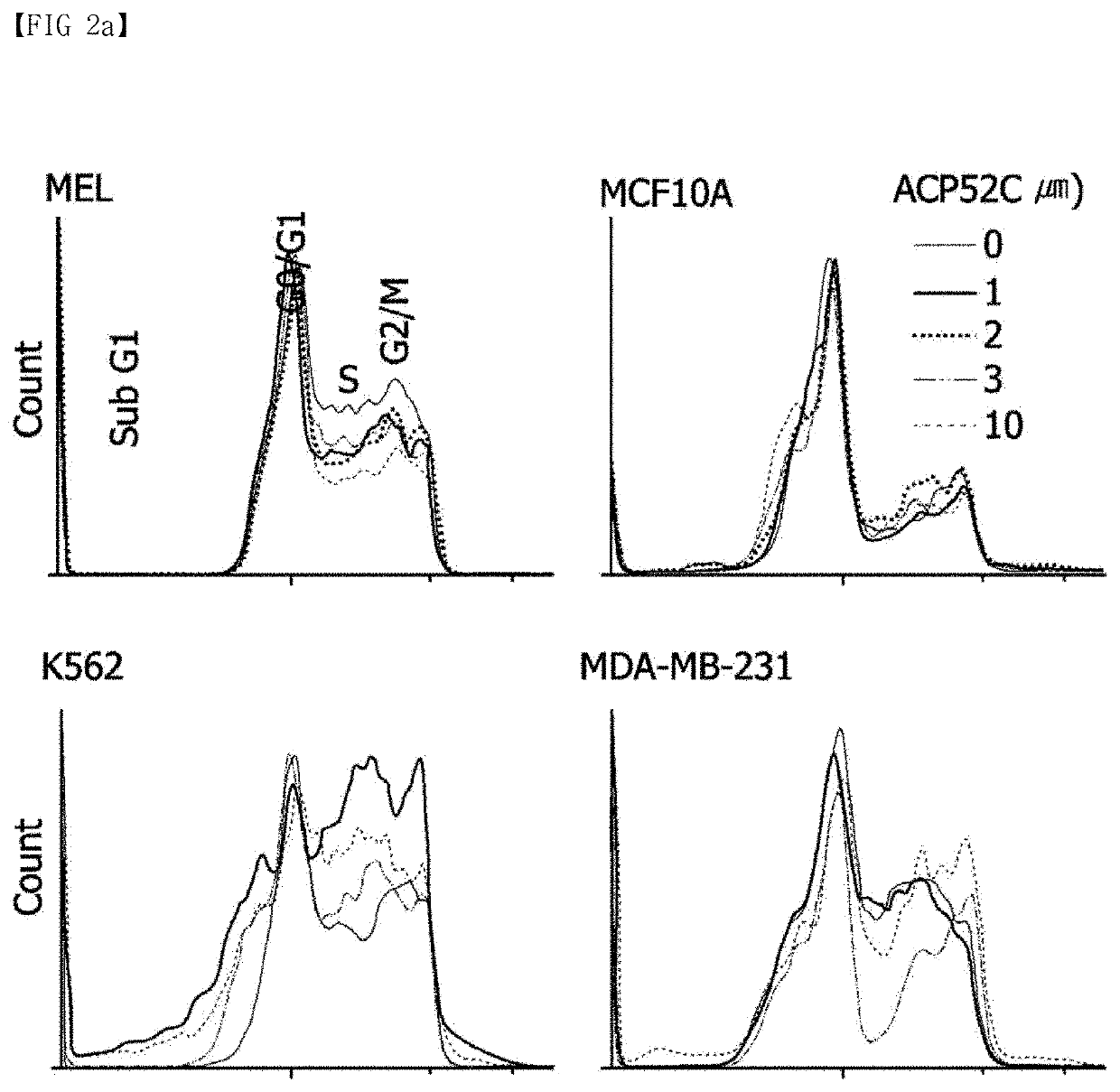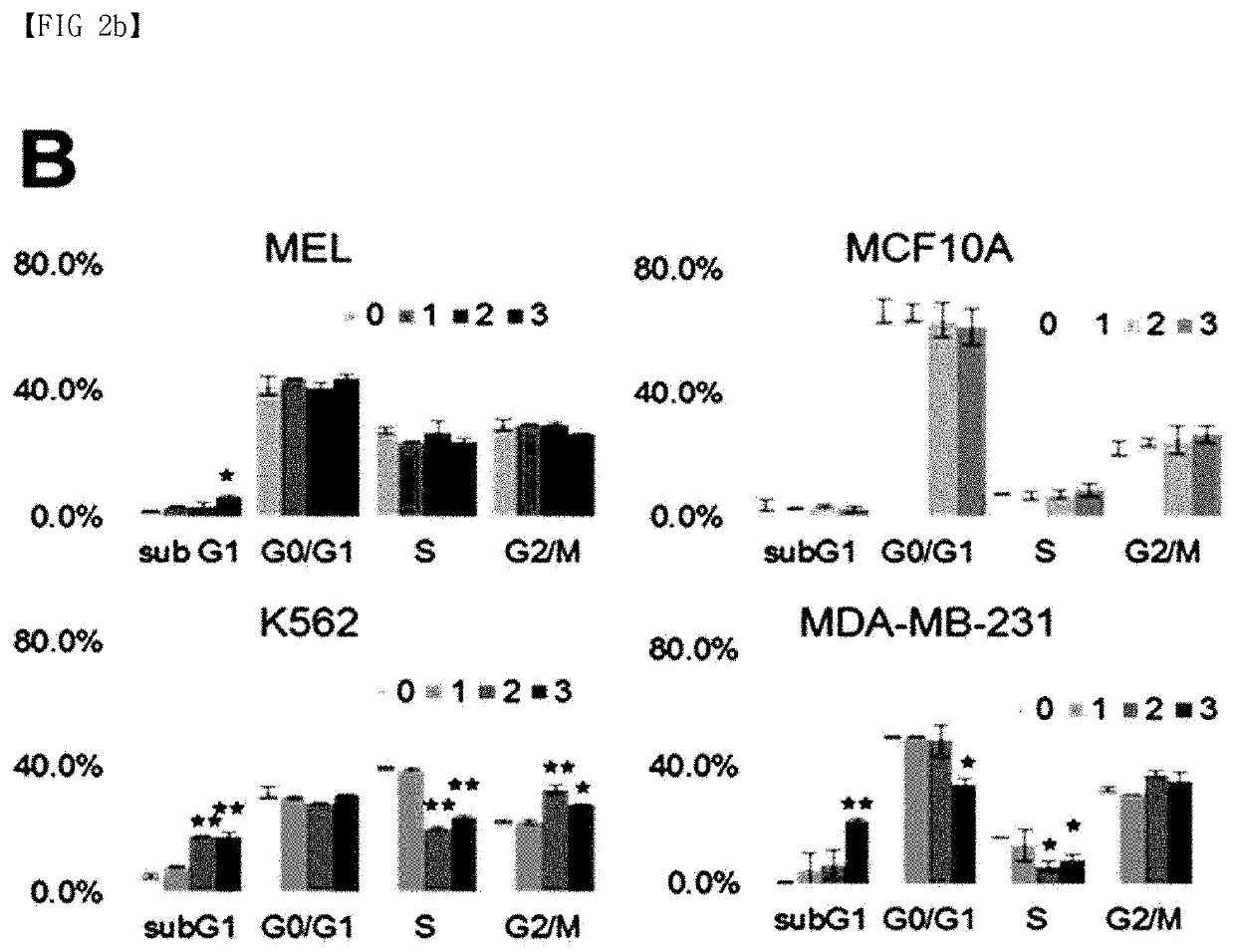Cp2c-targeting peptide-based anticancer agent
- Summary
- Abstract
- Description
- Claims
- Application Information
AI Technical Summary
Benefits of technology
Problems solved by technology
Method used
Image
Examples
example 1
[Example 1] Confirmation of Anti-Cancer Effect of ACP52C
[0074]The selected peptide binds to CP2c and inhibits the formation of a transcription factor complex including CP2c (CP2c homotetramer and CP2c / CP2b / PIAS1 heterohexamer), thereby indirectly interfering with DNA binding of CP2c. As a result of analyzing the anticancer effect in various carcinomas targeting the synthesized ACP52C, it was confirmed that it exhibits cancer cell-specific growth inhibition and cell death efficacy (FIG. 1).
[0075]The growth inhibitory and cell death-inducing efficacy of ACP52C was confirmed by FACS analysis by treating cells with ACP52C after synchronizing the cell cycle to the G1 / S phase through a double thymidine block method. As a result, it was confirmed that a polyploid was formed while with cell cycle arrest at the G2 / M phase. On the other hand, it was confirmed that, when ACP52C was applied to the cell line synchronized to the G2 / M phase with thymidine / nocodazole treatment, the cell cycle was a...
preparation example 2
[Preparation Example 2] Synthesis of CP2c-Targeting Peptide-Fatty Acid Conjugates
[0079]Our data suggest that ACP52C might be unstable in vivo although ACP52C showed a good anticancer activity. As an effort to improve in vivo stability of ACP52C, 4 types of albumin-affinity C16 fatty acid (palmitoyl acid)-conjugated peptides were synthesized (FIG. 7). Each peptide whose N-terminus and C-terminus were modified was synthesized, and then a C16 fatty acid was conjugated to each of them.
example 2
[Example 2] Confirmation of In Vitro Anticancer Effect of CP2c-Targeting Peptide-Fatty Acid Conjugate
[0080]The anticancer effect of the CP2c-targeting peptide-fatty acid conjugate synthesized in Preparation Example 2 was analyzed in various cancer cells. As a result, all three types of C16 fatty acid-binding peptides {ACP52CG (=ACP52CG-E), ACP52CK (=ACP52CG-GFLGE), and ACP52CGK} induced cancer cell-specific cell death similarly to the control group (ACP52C), and the GI50 values calculated at 48 hours after treatment were like or more efficient than that of the control (FIGS. 8a to 8d, FIGS. 10a to 10g). In addition, after treatment with ACP52CG and ACP52CK for various cancer cell lines with different p53 mutations, cell survival curves and GI50 values were calculated through MTT assay. As a result, although the GI50 value for each cell line showed a deviation, it was 10 mM or less, which was clearly distinguished from the result of the normal cell line (about 1,000 mM) (FIGS. 9a to ...
PUM
| Property | Measurement | Unit |
|---|---|---|
| Cell death | aaaaa | aaaaa |
| Stability | aaaaa | aaaaa |
Abstract
Description
Claims
Application Information
 Login to View More
Login to View More - R&D
- Intellectual Property
- Life Sciences
- Materials
- Tech Scout
- Unparalleled Data Quality
- Higher Quality Content
- 60% Fewer Hallucinations
Browse by: Latest US Patents, China's latest patents, Technical Efficacy Thesaurus, Application Domain, Technology Topic, Popular Technical Reports.
© 2025 PatSnap. All rights reserved.Legal|Privacy policy|Modern Slavery Act Transparency Statement|Sitemap|About US| Contact US: help@patsnap.com



